Payments for Unrealized Receivables and Inventory Items
If a partner receives money or property in exchange for any part of a partnership interest, the amount due to his or her share of the partnership's unrealized receivables or inventory items results in ordinary income or loss. This amount is treated as if it were received for the sale or exchange of property that is not a capital asset.
This treatment applies to the unrealized receivables part of payments to a retiring partner or successor in interest of a deceased partner only if that part is not treated as paid in exchange for partnership property. See Liquidation at Partner's Retirement or Death, earlier.
 For a sale or exchange of a partnership interest before August 6, 1997, inventory must be substantially appreciated before it generates ordinary income (rather than capital gain). This also applies to any sale or exchange under a written contract that is in effect on June 8, 1997, and at all times thereafter before the sale or exchange. For the definition of substantially appreciated, see Certain distributions treated as a sale or exchange under Partnership Distributions, earlier.
For a sale or exchange of a partnership interest before August 6, 1997, inventory must be substantially appreciated before it generates ordinary income (rather than capital gain). This also applies to any sale or exchange under a written contract that is in effect on June 8, 1997, and at all times thereafter before the sale or exchange. For the definition of substantially appreciated, see Certain distributions treated as a sale or exchange under Partnership Distributions, earlier.
Unrealized receivables. Unrealized receivables include any rights to payment not already included in income for the following items.
- Goods delivered or to be delivered to the extent the payment would be treated as received for property other than a capital asset.
- Services rendered or to be rendered.
These rights must have arisen under a contract or agreement that existed at the time of sale or distribution, even though the partnership may not be able to enforce payment until a later date. For example, unrealized receivables include accounts receivable of a cash method partnership and rights to payment for work or goods begun but incomplete at the time of the sale or distribution of the partner's share.
The basis for any unrealized receivables includes all costs or expenses for the receivables that were paid or accrued but not previously taken into account under the partnership's method of accounting.
Other items treated as unrealized receivables. Unrealized receivables include potential gain that would be ordinary income if the following partnership property were sold at its fair market value on the date of the payment.
- Mining property for which exploration expenses were deducted.
- Stock in a Domestic International Sales Corporation (DISC).
- Certain farm land for which expenses for soil and water conservation or land clearing were deducted.
- Franchises, trademarks, or trade names.
- Oil, gas, or geothermal property for which intangible drilling and development costs were deducted.
- Stock of certain controlled foreign corporations.
- Market discount bonds and short-term obligations.
- Property subject to recapture of depreciation under sections 1245 and 1250 of the Internal Revenue Code. Depreciation recapture is discussed in chapter 3 of Publication 544.
Determining value. Generally, the sales price of unrealized receivables, or their value if received in a distribution treated as a sale or exchange, is determined by any arm's-length agreement between the buyer and the seller (or between the partnership and the partner receiving the distribution).
If no agreement exists, the price or value must be determined by taking into account both the estimated cost to complete performance of the contract or agreement and the time between the sale or distribution and the time of payment.
Example. You are a partner in ABC Partnership. The adjusted basis of your partnership interest at the end of the current year is zero. Your share of potential ordinary income from partnership depreciable property is $5,000. The partnership has no other unrealized receivables or inventory items. You sell your interest in the partnership for $10,000 in cash and you report the entire amount as a gain since your adjusted basis in the partnership is zero. You report as ordinary income your $5,000 share of potential ordinary income from the partnership's depreciable property. The remaining $5,000 gain is a capital gain.
Inventory items. Inventory items are not just stock-in-trade of the partnership. They also include the following property.
- Property that would properly be included in the partnership's inventory if on hand at the end of the tax year or that is held primarily for sale to customers in the normal course of business.
- Property that, if sold or exchanged by the partnership, would not be a capital asset or section 1231 property (real or depreciable business property held more than one year). For example, accounts receivable acquired for services or from the sale of inventory and unrealized receivables are inventory items.
- Property held by the partnership that would be considered inventory if held by the partner selling the partnership interest or receiving the distribution.
Notification required of partner. If a partner exchanges a partnership interest attributable to unrealized receivables or inventory for money or property, he or she must notify the partnership in writing. This must be done within 30 days of the transaction or, if earlier, by January 15 of the calendar year following the calendar year of the exchange. A partner may be subject to a $50 penalty for each failure to notify the partnership about such a transaction, unless the failure was due to reasonable cause and not willful neglect.
Information return required of partnership. When a partnership is notified of an exchange of partnership interests involving unrealized receivables or inventory items, the partnership must file Form 8308. Form 8308 is filed with Form 1065 for the tax year that includes the last day of the calendar year in which the exchange took place. If notified of an exchange after filing Form 1065, the partnership must file Form 8308 separately, within 30 days of the notification.
On Form 8308, the partnership states the date of the exchange and the names, addresses, and taxpayer identification numbers of the partnership filing the return and the transferee and transferor in the exchange. The partnership must also provide a copy of Form 8308 (or a written statement with the same information) to each transferee and transferor by the later of January 31 following the end of the calendar year or 30 days after it receives notice of the exchange.
The partnership may be subject to a penalty of up to $50 for each failure to timely file Form 8308 and a $50 penalty for each failure to furnish a copy of Form 8308 to a transferor or transferee, unless the failure is due to reasonable cause and not willful neglect. If the failure is intentional, a higher penalty may be imposed. See the form instructions for details.
Statement required of partner. If a partner sells or exchanges any part of an interest in a partnership having unrealized receivables or inventory, he or she must file a statement with his or her tax return for the year in which the sale or exchange occurs. The statement must contain the following information.
- The date of the sale or exchange.
- The amount of any gain or loss attributable to the unrealized receivables or inventory.
- The amount of any gain or loss attributable to capital gain or loss on the sale of the partnership interest.
Partner's disposition of distributed unrealized receivables or inventory items. In general, any gain or loss on a sale or exchange of unrealized receivables or inventory items a partner received in a distribution is an ordinary gain or loss. For this purpose, inventory items do not include real or depreciable business property, even if they are not held more than 1 year.
Example. Mike, a distributee partner, received his share of accounts receivable when his law firm dissolved. The partnership used the cash method of accounting, so the receivables had a basis of zero. If Mike later collects the receivables or sells them, the amount he receives will be ordinary income.
Exception for inventory items held more than 5 years. If a distributee partner sells inventory items held for more than 5 years after the distribution, the type of gain or loss depends on how they are being used on the date sold. The gain or loss is capital gain or loss if the property is a capital asset in the partner's hands at the time sold.
Example. Ann receives, through dissolution of her partnership, inventory that has a basis of $19,000. Within 5 years, she sells the inventory for $24,000. The $5,000 gain is taxed as ordinary income. If she had held the inventory for more than 5 years, her gain would have been capital gain, provided the inventory was a capital asset in her hands at the time of sale.
Substituted basis property. If a distributee partner disposes of unrealized receivables or inventory items in a nonrecognition transaction, ordinary gain or loss treatment applies to a later disposition of any substituted basis property resulting from the transaction.
Adjusting the Basis of Partnership Property
Generally, a partnership cannot adjust the basis of its property because of a distribution of property to a partner or because of a transfer of an interest in the partnership, whether by sale or exchange or because of the death of a partner. The partnership can adjust the basis only if it files an election to make an optional adjustment to the basis of its property upon all distributions and transfers. A partnership does not adjust the basis of partnership property for a contribution of property, including money, to the partnership.
Distributions. When there is a distribution of partnership property to a partner, the partnership makes the optional adjustment by:
- Increasing the adjusted basis of the retained partnership property by:
- Any gain recognized by the distributee partner on the distribution, plus
- The excess, if any, of the partnership's adjusted basis for the distributed property (immediately before the distribution) over the basis of the property to the distributee, or
- Decreasing the adjusted basis of the retained partnership property by:
- Any loss recognized by the distributee partner on the distribution, plus
- The excess, if any, of the distributee partner's basis for the distributed property over the partnership's adjusted basis for the property (immediately before the distribution).
Timing of adjustment. If a partnership completely liquidates the interest of a partner by making a series of cash payments treated as distributions of the partner's interest in partnership property, the basis adjustments to partnership property must correspond in timing and amount with the recognition of gain or loss by the retiring partner, or a deceased partner's successor in interest, with respect to those payments.
Example. Alan owns a one-third interest in the partnership Sylvan Associates. Sylvan has an optional adjustment to basis election in effect. When Alan retires, Sylvan continues without dissolution and agrees to liquidate Alan's one-third interest in the partnership property by making a series of cash payments to Alan that are treated as distributions. The total amount of payments Alan will receive is fixed and exceeds the adjusted basis of Alan's interest in the partnership.
Sylvan increases the adjusted basis of its property by Alan's recognized gain in each partnership tax year during which Alan recognizes gain with respect to the payments.
Transfers. When there is a transfer of a partnership interest because of a sale or exchange or a partner's death, the partnership makes the optional adjustment by:
- Increasing the adjusted basis of the partnership property by the excess of:
- The transferee's basis for his or her partnership interest, over
- The transferee's share of the adjusted basis of all partnership property, or
- Decreasing the adjusted basis of partnership property by the excess of:
- The transferee's share of the adjusted basis of all partnership property, over
- The transferee's basis for his or her partnership interest.
These adjustments affect the basis of partnership property for the transferee partner only. They become part of his or her share of the common partnership basis.
Making the election. The optional adjustment to basis is made by filing a written statement with Form 1065 for the tax year in which the distribution or transfer occurs. For the election to be valid, the return must be filed on time, including extensions. The statement must include the name and address of the partnership, be signed by one of the partners, and state that the partnership elects under section 754 to apply sections 734(b) and 743(b) of the Internal Revenue Code. Once a valid election has been made, it applies in succeeding years until it is revoked.
If the election cannot be made with the return, a partner or the partnership can request an automatic extension of 12 months to make the election. See section 301.9100-2 of the regulations for more information.
Revoking the election. Generally, the election can be revoked only with the approval of the IRS. An application to revoke the election must be filed with the IRS director for your area. This application must be filed within 30 days after the close of the partnership tax year for which the change is to be effective. The application must be signed by one of the partners and state why the partnership wishes to revoke the election.
Examples of sufficient grounds for approving the application include the following.
- A change in the nature of the business.
- A substantial increase in assets.
- A change in the character of the assets.
- An increased frequency of retirements or shifts of partnership interests.
However, the IRS will not approve an application to revoke the election if its primary purpose is to avoid decreasing the basis of partnership assets upon a transfer or distribution.
Form 1065 Example
This filled-in Form 1065 is for the AbleBaker Book Store, a partnership composed of Frank Able and Susan Baker. The partnership uses an accrual method of accounting and a calendar year for reporting income and loss. Frank works full time in the business, while Susan works approximately 25% of her time in it. Both partners are general partners.
The partnership agreement states that Frank will receive a yearly guaranteed payment of $20,000 and Susan will receive $5,000. Any profit or loss will be shared equally by the partners. The partners are personally liable for all partnership liabilities. Both partners materially participate in the operation of the business.
In addition to receiving income and paying expenses in its partnership operations, AbleBaker made a $650 cash charitable contribution, received $150 from dividends, and received $50 tax-exempt interest from municipal bonds.
Frank completes the partnership's Form 1065 as explained next.
Page 1
The IRS sent Frank a postcard with the partnership's preaddressed label, asking if he needed a Form 1065 package. He returned the postcard and the IRS sent him the package. When Frank completes the return, he places the partnership's label in the address area on page 1.
Frank supplies all the information requested at the top of the page.
Income
The partnership's ordinary income from the trade or business activity is shown on lines 1a through 8.
Line 1. Gross sales of $409,465 are entered on line 1a. Returns and allowances of $3,365 are entered on line 1b, resulting in net sales of $406,100, entered on line 1c.
Line 2. Cost of goods sold, $267,641, from Schedule A, line 8, is entered here.
Line 3. Gross profit of $138,459 is shown on this line.
Line 7. Interest income on accounts receivable, $559, is entered on this line. The schedule that must be attached for this line is not shown.
Line 8. Total income, $139,018 (lines 3 through 7), is shown here.
Deductions
The partnership's allowable deductions are shown on lines 9 through 21.
Line 9. All salaries and wages are included here except guaranteed payments to partners (shown on line 10). Frank enters the $29,350 wages paid to the partnership's employees. The partnership had no employment credits to reduce that amount.
Line 10. Guaranteed payments of $25,000 to partners Frank ($20,000) and Susan ($5,000) are entered here.
Line 11. Repairs of $1,125 made to partnership equipment are entered on this line.
Line 12. During the year, $250 owed to the partnership was determined to be a wholly worthless business bad debt. The $250 is shown on this line. (If this had been a nonbusiness bad debt, it would have been reported in Part I of Schedule D (Form 1065) and included separately on Schedules K and K-1, line 7, as a stated short-term capital loss.)
Line 13. Rent paid for the business premises, $20,000, is listed on this line.
Line 14. Deductible taxes of $3,295 are entered on this line.
Line 15. Interest paid to suppliers during the year totaled $1,451. This is business interest, so it is entered here.
Lines 16a and 16c. Depreciation of $1,174 claimed on assets used in the partnership's business is entered on these lines. (Line 16b is left blank because there is no depreciation listed elsewhere on the return.) Frank does not need to attach Form 4562 because the partnership did not place property in service during 2002 or depreciate or claim a deduction for a car or other listed property.
Line 20. Other allowable deductions of $8,003 not listed elsewhere on the return and for which a separate line is not provided on page 1 are included on this line. Frank attaches a schedule that lists each deduction and the amount included on line 20. This schedule is not shown.
Line 21. The total of all deductions, $89,648 (lines 9 through 20), is entered on this line.
Ordinary Income (Loss)
Line 22. The amount on line 21 is subtracted from the amount on line 8. The result, $49,370, is entered here and on line 1 of Schedule K. The amount allocated to each partner is listed on line 1 of Schedule K-1.
Signatures
Frank signs the return as a general partner. The AbleBaker Book Store did not have a paid preparer.
Page 2 Schedule A
Schedule A shows the computation of cost of goods sold. Beginning inventory, $18,125, is entered on line 1 and net purchases, $268,741, are entered on line 2. The total, $286,866, is entered on line 6. Ending inventory, $19,225 (entered on line 7), is subtracted from line 6 to arrive at cost of goods sold, $267,641 (entered on line 8 and on page 1, line 2).
Frank answers all applicable questions for item 9.
Schedule B
Schedule B contains 12 questions about the partnership. Frank answers question 1 by marking the Domestic general partnership box. He answers questions 2 through 11 by marking the No boxes. He answers question 12 by entering -0- on this line.
Question 5 asks if the partnership meets all the requirements listed in items 5a, b, and c. Because the partnership's total receipts were not less than $250,000, all three of these requirements are not met. Frank must complete Schedules L, M-1, M-2, and item F on page 1 of Form 1065 and item J on Schedule K-1.
Pages 3 - 4 Schedule K
On Schedule K, Frank lists the total of both partners' shares of income, deductions, credits, etc. Each partner's distributive share of income, deductions, credits, etc., is reported on Schedule K-1. The line items for Schedule K are discussed in combination with the Schedule K-1 line items, later.
Analysis of Net Income (Loss)
An analysis must be made of the distributive items on Schedule K. This analysis is based on the type of partner. Since the AbleBaker Book Store has two individual partners, both of whom are active general partners, the total on line 1, $73,870, is entered on line 2a, column ii.
Page 4 Schedules L, M-1, and M-2
Partnerships do not have to complete Schedules L, M-1, or M-2 if all the tests listed under question 5 of Schedule B are met and question 5 is marked Yes. The AbleBaker Book Store does not meet all the tests, so these schedules must be completed.
Schedule L
Schedule L contains the partnership's balance sheets at the beginning and end of the tax year. All information shown on the balance sheets for the AbleBaker Book Store should agree with its books of record.
The entry in column (d) of line 14 for total assets at the end of the year, $45,391, is carried to item F at the top of page 1 since the answer to question 5 on Schedule B was No.
Schedule M-1
Schedule M-1 is the reconciliation of income per the partnership books with income per Form 1065.
Line 1. This line shows the net income per books of $48,920. This amount is from the profit and loss account (not shown in this example).
Line 3. This line shows the guaranteed payments to partners.
Line 5. This is the total of lines 1 through 4 of $73,920.
Line 6. Shown here is the $50 tax-exempt interest income from municipal bonds recorded on the books but not included on Schedule K, lines 1 through 7. This interest is reported on Schedule K, line 19.
Line 9. This is line 5 less line 8, $73,870. This line is the same as line 1 of the Analysis of Net Income (Loss) section of Schedule K at the top of page 4.
Schedule M-2
Schedule M-2 is an analysis of the partners' capital accounts. It shows the total equity of all partners at the beginning and end of the tax year and the adjustments that caused any increase or decrease. The total of all the partners' capital accounts is the difference between the partnership's assets and liabilities shown on Schedule L. A partner's capital account does not necessarily represent the tax basis for an interest in the partnership.
Line 1. As of January 1, the total of the partners' capital accounts was $27,550 (Frank - $14,050; Susan - $13,500). This amount should agree with the beginning balance shown on line 21 of Schedule L for the partners' capital accounts.
Line 3. This is the net income per books.
Line 5. This is the total of lines 1 through 4.
Line 6. Each partner withdrew $26,440 (totaling $52,880) from the partnership. These withdrawals are shown here and on Schedule K, line 22. The partners' guaranteed payments, which were actually paid, are not included because they were deducted when figuring the amount shown on line 3.
Line 9. This shows the total equity of all partners as shown in the books of record as of December 31. This amount should agree with the year-end balance shown on line 21 of Schedule L for the partners' capital accounts.
Item J on Schedule K-1 reflects each partner's share of the amounts shown on lines 1 through 9 of Schedule M-2.
Schedule K-1 (Form 1065)
Schedule K-1 lists each partner's share of income, deductions, credits, etc. It also shows where to report the items on the partner's individual income tax return. Illustrated is a copy of the Schedule K-1 for Frank W. Able. All information asked for at the top of Schedule K-1 must be supplied for each partner.
Allocation of Partnership Items
The partners' shares of income, deductions, etc., are shown next.
Income (Loss)
Line 1. This line on Schedule K-1 shows Frank's share ($24,685) of the income from the partnership shown on Form 1065, page 1, line 22. The total amount of income to both partners is shown on line 1, Schedule K.
Line 4b. Dividends must be separately stated. They are not included in the income (loss) of the partnership on Form 1065, page 1, line 22. This line on Schedule K-1 shows Frank's share, $75. This line on Schedule K shows the total dividends of $150.
Line 5. This line on Schedule K-1 shows only the guaranteed payments to Frank of $20,000. This line on Schedule K shows the total guaranteed payments to both partners of $25,000.
Deductions
Line 8. During the year, the partnership made a $650 cash contribution to the American Lung Association. Each partner may be able to deduct his or her share of the partnership's charitable contribution on his or her individual income tax return if the partner itemizes deductions. Frank's share of the contribution, $325, is entered on this line of Schedule K-1. This line on Schedule K shows the total contribution.
Investment Interest
Line 14b. The partnership had no interest expense on investment debts, but it had investment income (dividends) of $150 as shown on line 4b, Schedule K. That amount is also shown on this line of Schedule K, and the partner's share is shown on this line of Schedule K-1.
Self-Employment
Line 15a. Net earnings (loss) from self-employment are figured using the worksheet in the Form 1065 instructions for Schedule K (not shown). Frank and Susan's net earnings from self-employment are the total of the partnership income shown on line 1 of Schedule K and the guaranteed payments shown on line 5. This total, $74,370, is entered on Schedule K, and each individual partner's share is shown on his or her Schedule K-1. Each partner uses his or her share to figure his or her self-employment tax on Schedule SE (Form 1040), Self-Employment Tax (not shown).
Other
Line 19. Frank enters the $50 municipal bond interest received by the partnership on this line of Schedule K and $25 on this line of each partner's Schedule K-1.
Line 22. Frank enters the $52,880 cash withdrawals made by the partners during the year on this line of Schedule K. He enters the amount each partner withdrew on this line of the partner's Schedule K-1.
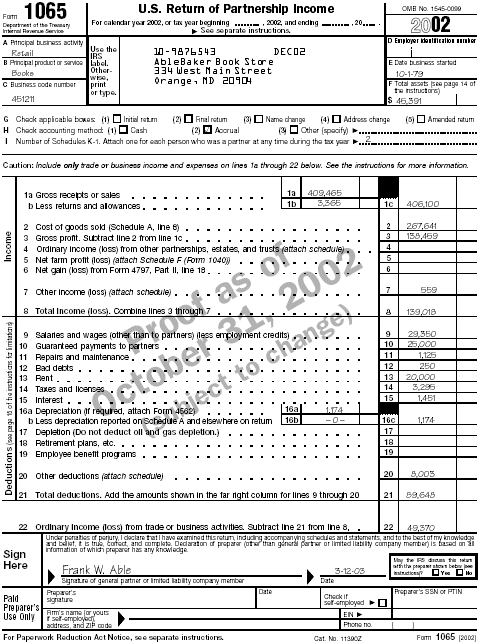
Form 1065 page 1
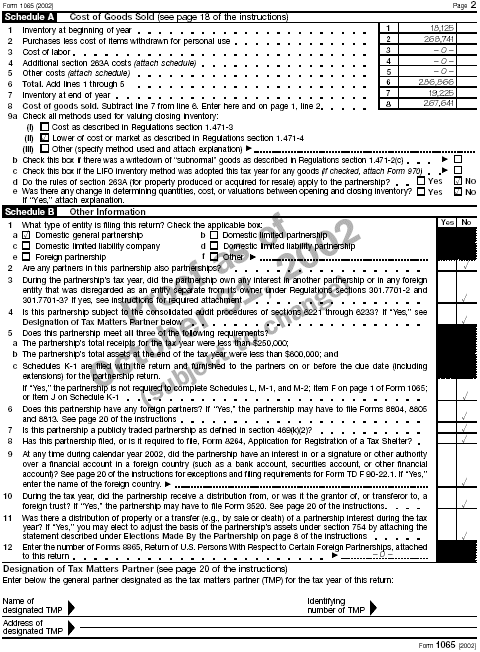
Form 1065 page 2
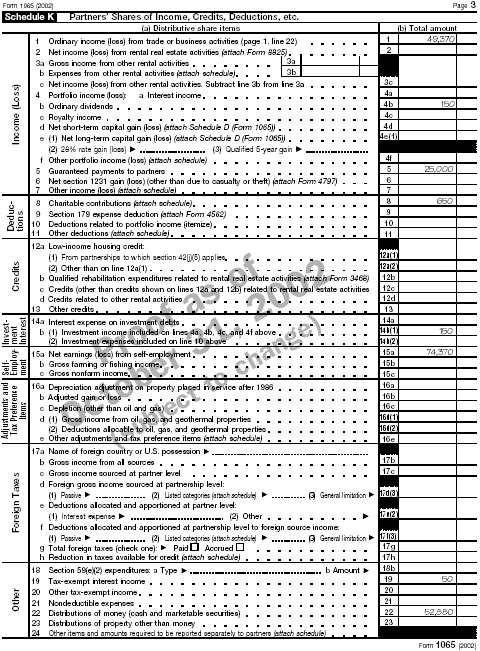
Form 1065 page 3
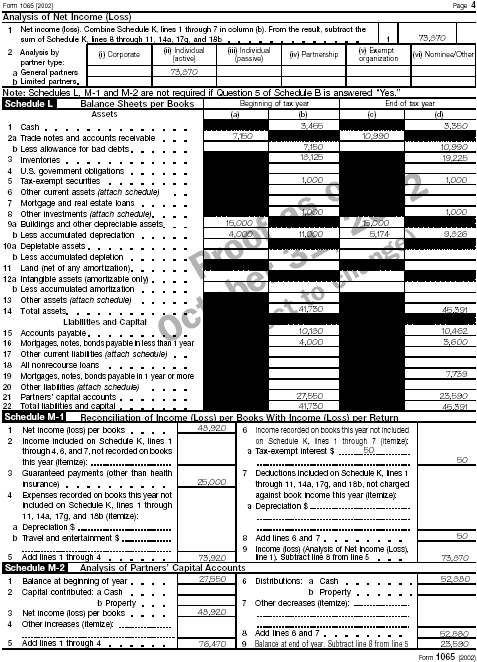
Form 1065 page 4
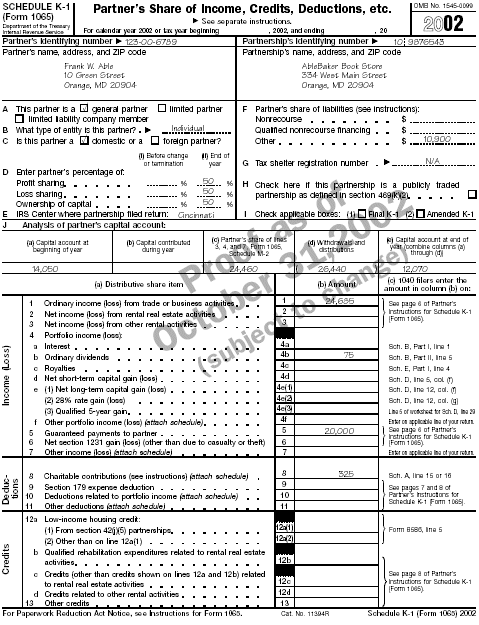
Schedule K–1 page 1
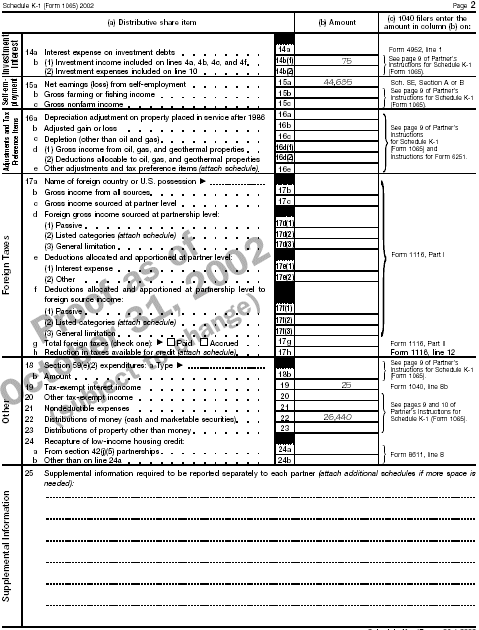
Schedule K–1 page 2
How To Get Tax Help
You can get help with unresolved tax issues, order free publications and forms, ask tax questions, and get more information from the IRS in several ways. By selecting the method that is best for you, you will have quick and easy access to tax help.
Contacting your Taxpayer Advocate. If you have attempted to deal with an IRS problem unsuccessfully, you should contact your Taxpayer Advocate.
The Taxpayer Advocate represents your interests and concerns within the IRS by protecting your rights and resolving problems that have not been fixed through normal channels. While Taxpayer Advocates cannot change the tax law or make a technical tax decision, they can clear up problems that resulted from previous contacts and ensure that your case is given a complete and impartial review.
To contact your Taxpayer Advocate:
- Call the Taxpayer Advocate at
1-877-777-4778.
- Call, write, or fax the Taxpayer Advocate office in your area.
- Call 1-800-829-4059 if you are a
TTY/TDD user.
For more information, see Publication 1546, The Taxpayer Advocate Service of the IRS.
Free tax services. To find out what services are available, get Publication 910, Guide to Free Tax Services. It contains a list of free tax publications and an index of tax topics. It also describes other free tax information services, including tax education and assistance programs and a list of TeleTax topics.
 Personal computer. With your personal computer and modem, you can access the IRS on the Internet at www.irs.gov. While visiting our web site, you can:
Personal computer. With your personal computer and modem, you can access the IRS on the Internet at www.irs.gov. While visiting our web site, you can:
- See answers to frequently asked tax questions or request help by e-mail.
- Download forms and publications or search for forms and publications by topic or keyword.
- Order IRS products on-line.
- View forms that may be filled in electronically, print the completed form, and then save the form for recordkeeping.
- View Internal Revenue Bulletins published in the last few years.
- Search regulations and the Internal Revenue Code.
- Receive our electronic newsletters on hot tax issues and news.
- Learn about the benefits of filing electronically (IRS e-file).
- Get information on starting and operating a small business.
You can also reach us with your computer using File Transfer Protocol at ftp.irs.gov.
 TaxFax Service. Using the phone attached to your fax machine, you can receive forms and instructions by calling 703-368-9694. Follow the directions from the prompts. When you order forms, enter the catalog number for the form you need. The items you request will be faxed to you.
TaxFax Service. Using the phone attached to your fax machine, you can receive forms and instructions by calling 703-368-9694. Follow the directions from the prompts. When you order forms, enter the catalog number for the form you need. The items you request will be faxed to you.
For help with transmission problems, call the FedWorld Help Desk at 703-487-4608.
 Phone. Many services are available by phone.
Phone. Many services are available by phone.
- Ordering forms, instructions, and publications. Call 1-800-829-3676 to order current and prior year forms, instructions, and publications.
- Asking tax questions. Call the IRS with your tax questions at 1-800-829-4933.
- Solving problems. Take advantage of Everyday Tax Solutions service by calling your local IRS office to set up an in-person appointment at your convenience. Check your local directory assistance or www.irs.gov for the numbers.
- TTY/TDD equipment. If you have access to TTY/TDD equipment, call 1-800-829- 4059 to ask tax questions or to order forms and publications.
- TeleTax topics. Call 1-800-829-4477 to listen to pre-recorded messages covering various tax topics.
Evaluating the quality of our telephone services. To ensure that IRS representatives give accurate, courteous, and professional answers, we use several methods to evaluate the quality of our telephone services. One method is for a second IRS representative to sometimes listen in on or record telephone calls. Another is to ask some callers to complete a short survey at the end of the call.
 Walk-in. Many products and services are available on a walk-in basis.
Walk-in. Many products and services are available on a walk-in basis.
- Products. You can walk in to many post offices, libraries, and IRS offices to pick up certain forms, instructions, and publications. Some IRS offices, libraries, grocery stores, copy centers, city and county governments, credit unions, and office supply stores have an extensive collection of products available to print from a CD-ROM or photocopy from reproducible proofs. Also, some IRS offices and libraries have the Internal Revenue Code, regulations, Internal Revenue Bulletins, and Cumulative Bulletins available for research purposes.
- Services. You can walk in to your local IRS office to ask tax questions or get help with a tax problem. Now you can set up an appointment by calling your local IRS office number and, at the prompt, leaving a message requesting Everyday Tax Solutions help. A representative will call you back within 2 business days to schedule an in-person appointment at your convenience.
 Mail. You can send your order for forms, instructions, and publications to the Distribution Center nearest to you and receive a response within 10 workdays after your request is received. Find the address that applies to your part of the country.
Mail. You can send your order for forms, instructions, and publications to the Distribution Center nearest to you and receive a response within 10 workdays after your request is received. Find the address that applies to your part of the country.
- Western part of U.S.:
Western Area Distribution Center
Rancho Cordova, CA 95743-0001
- Central part of U.S.:
Central Area Distribution Center
P.O. Box 8903
Bloomington, IL 61702-8903
- Eastern part of U.S. and foreign addresses:
Eastern Area Distribution Center
P.O. Box 85074
Richmond, VA 23261-5074
 CD-ROM for tax products. You can order IRS Publication 1796, Federal Tax Products on CD-ROM, and obtain:
CD-ROM for tax products. You can order IRS Publication 1796, Federal Tax Products on CD-ROM, and obtain:
- Current tax forms, instructions, and publications.
- Prior-year tax forms and instructions.
- Popular tax forms that may be filled in electronically, printed out for submission, and saved for recordkeeping.
- Internal Revenue Bulletins.
The CD-ROM can be purchased from National Technical Information Service (NTIS) by calling 1-877-233-6767 or on the Internet at http://www.irs.gov/cdorders. The first release is available in early January and the final release is available in late February.
 CD-ROM for small businesses. IRS Publication 3207, Small Business Resource Guide, is a must for every small business owner or any taxpayer about to start a business. This handy, interactive CD contains all the business tax forms, instructions, and publications needed to successfully manage a business. In addition, the CD provides an abundance of other helpful information, such as how to prepare a business plan, finding financing for your business, and much more. The design of the CD makes finding information easy and quick and incorporates file formats and browsers that can be run on virtually any desktop or laptop computer.
CD-ROM for small businesses. IRS Publication 3207, Small Business Resource Guide, is a must for every small business owner or any taxpayer about to start a business. This handy, interactive CD contains all the business tax forms, instructions, and publications needed to successfully manage a business. In addition, the CD provides an abundance of other helpful information, such as how to prepare a business plan, finding financing for your business, and much more. The design of the CD makes finding information easy and quick and incorporates file formats and browsers that can be run on virtually any desktop or laptop computer.
It is available in March. You can get a free copy by calling 1-800-829-3676 or by visiting the website at www.irs.gov/smallbiz.
Previous | First
Publication Index | 2002 Tax Help Archives | Tax Help Archives | Home
